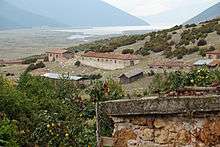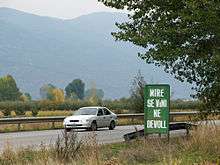Devoll, Korçë
| Devoll | ||
|---|---|---|
| Municipality | ||
| ||
 Devoll | ||
| Coordinates: 40°38′N 20°59′E / 40.633°N 20.983°ECoordinates: 40°38′N 20°59′E / 40.633°N 20.983°E | ||
| Country |
| |
| County | Korçë | |
| Government | ||
| • Mayor | Bledjon Nallbati (DP) | |
| Area | ||
| • Municipality | 453.27 km2 (175.01 sq mi) | |
| Population (2011) | ||
| • Municipality | 26,716 | |
| • Municipality density | 59/km2 (150/sq mi) | |
| Time zone | CET (UTC+1) | |
| • Summer (DST) | CEST (UTC+2) | |
| Postal Code | 7006 | |
| Area Code | (0)811 | |
| Vehicle registration | AL | |
| Website | Official Website | |
Devoll is a municipality in Korçë County, southeastern Albania. It was created in 2015 by the merger of the former municipalities Bilisht, Hoçisht, Miras, Progër and Qendër Bilisht. The seat of the municipality is the town Bilisht.[1] The total population is 26,716 (2011 census), in a total area of 453.27 km2.[2] It is coterminous with the former Devoll District.
Geography
Devoll is located at the southeastern limit of the country. The border settlement Kapshticë is not far from the easternmost point in Albania. The entire eastern and southern borders of the municipality are also the national border with Greece. On the western and northern sides, the municipality neighbours Kolonjë, Korçë, Maliq and Pustec.

The municipality is located in the upper reaches of the Devoll river, which originates in the southwestern part of the area. Bilisht is located at around 900 m above sea level on a plain which is surrounded on all sides by mountains. The bordertown of Kapshticë is located at a height of 1048 m mountain pass. The western border is formed by the Malet i Moravës mountain range, whose highest mountain is the 1806 m high Maja e Lartë. The city of Korçë lies on the other side of this mountain range. There are only three passes through these mountains. In the northwest, the Devoll flows through a narrow canyon into the Plain of Korçë. In the northeast a long arm of the Small Prespa Lake stretches almost all the way to the Plain of Bilisht. In the southeast, the plain breaks off here and there almost imperceptibly into the Kore river valley, which cuts through the mountains here. This river, which is a tributary of the Haliacmon, makes a detour through Albanian territory of about 5 km. The few square kilometres of its drainage basin located in Albania are the only part of Albania which drains into the Aegean Sea rather than the Adriatic or Ionian Seas.
The Plain of Bilisht has been made fertile by means of numerous irrigation canals. As a result of heavy rainfall and spring snow melt, the water flows out of the Small Prespa Lake through a natural outlet, into the Devoll and then directly into the Adriatic. From the 1950s, until around 2000, the Devoll was redirected into the Small Prespa Lake during floods. The excess water was used to irrigate the Korçë Plain.
In the mountains east of Bilisht, along the Greek border, there are rich nickel deposits, concentrated in two main deposits, at Verniku and Kapshtica West.[3]
History
In the area of the municipality there are cave paintings from the Iron Age (at Tran) and Illyrian graves with jewellery (at Kuç). The chapel in the Blashtonjë cave on the edge of the Small Prespa Lake dates to the 13th century AD. The cave paintings are the oldest artworks which have been found in Albania and the icons in the chapel are among the oldest of their kind in the country.
Before the Second World War, the Devoll valley was an autonomous district. In the Communist period, it belonged to the Korçë region, which it was separated from in 1990 as part of the reform of administrative divisions. In the territorial reforms of 2015, the municipalities of Devoll region were transformed into the new municipality of Devoll, which was placed within Korçë County.
Economy

The border settlement of Kapshticë is among the most important routes from Albania into Greece. As a result the whole region, which is isolated from the rest of Albania, is heavily dedicated to border trade with Greece. Despite being a primarily agricultural area a large service industry has developed around the border trade. In particular, many young men of this area worked in Greece in the 1990s, mostly illegally, in order to escape the poverty at home. Subsequently, it often happened that their families have joined them.
References
- ↑ Law nr. 115/2014
- ↑ Interactive map administrative territorial reform
- ↑ "European Nickel says Devolli site in Albania resource estimate 426,775 tonnes". 2007-11-22. Retrieved 2015-08-10.
Bibliography
- Gilles de Rapper (2002). "Grenzen überschreiten. Migration in der albanischen Grenzregion Devoll". In Karl Kaser, Robert Pichler, Stephanie Schwander-Sievers. Die weite Welt und das Dorf. Albanische Emigration am Ende des 20. Jahrhunderts = Zur Kunde Südosteuropas: Albanologische Studien. Bd. 3. Wien: Böhlau-Verlag. ISBN 3-205-99413-2.
- Gilles de Rapper (2008). Religion in Post-communist Albania – Muslims, Christians and the idea of ‚culture‘ (Devoll, Southern Albania) (PDF). Anthropological Notebooks. 14 (2). pp. 31–45.



